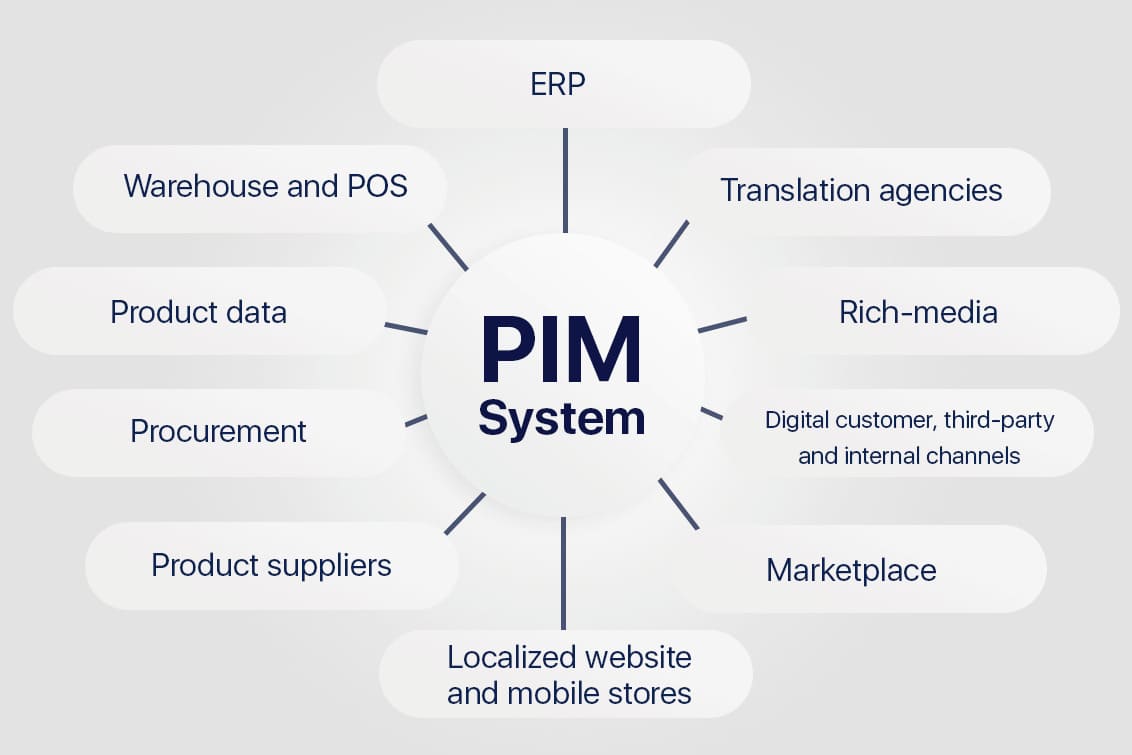The benefits of the Product Information Management systems (PIMs) might seem unclear for some people, but sales managers know better than to underestimate the importance of such tools. In rapidly growing businesses, where products and product updates rush into the world, marketers and salespeople feel extremely challenged in their efforts to provide the most accurate information for the constantly changing product features and final prices. Finding necessary data is a time-consuming and sometimes thankless task as it requires checking multiple sources with no guarantee of getting the latest information.
Prior to the introduction of PIM systems, about 83% of employees at manufacturing companies spent over 2 hours per week looking for product information. The software lowered the percentage to 64%; while in retails, the rate dropped to 42%.
When you need a Product Information Management Systems
Of course, if you have a small company with low manufacturing capacities, you’d probably be able to deal with your product range without getting lost in the informational pool.
However, as your company grows, the problems start piling up. The first flags usually involve hundreds of product references, heaps of documents, numerous media and sales channels, increments of physical and digital distribution outlets, new providers, extensive databases, catalogs, and local and global networks.
You can hire more salespeople to handle the growing number of products, but it won’t solve the fundamental difficulties they’d inevitably face trying to sell your products. Project Information Management Systems, on the other hand, do not require additional staff inflow. Since the main functions of such systems are tidying up the previously chaotic product information, analyzing it and automating the stale processes, PMI is considered a valued organizational tool saving time and increasing sales rates.

What is a PIM – brief software introduction
We have settled how essential PIM is; now let’s clarify exactly what it is.
You have probably heard of other PIM relatives such as Task Management Software and Human Resources Management Software. PIM exercises the same principles only it targets marketing and sales employees.
It is a software kit empowering a company with the ability to gather, store and check the information related to the company’s products. PIM ensures the centralized environment for operating the product data using a single interface for all enterprise-wide databases. Such systems drive important changes to the overall product management practices:
- By eliminating any excessive documentation and organizing fluent data flow throughout various documents, spreadsheets, CSVs, SKUs, images, and videos.
- By saving the time of dedicated personnel and increasing overall team efficiency through product information synchronization and network-wide updates, automated processes of catalogs and promo materials creation.
- By preparing personalized quality reports born through the analysis of your reports and following revised imperfections in your content.

The majority of Project Information Management systems also offer useful tools for testing, validating and publishing your marketing content automatically.
The application of Product Information Management software is crucial for e-commerce business processes, where companies are striving to procure the global presence of their products. The tool reconciles available product data, coordinates the delivery of a single product information view and ensures high data quality using verification and adjustment techniques.
Practical benefits of the system
Though the advantages of the software are simple and true, you might still wonder how you can improve the manufacturing workflow of your company. Below are the most popular implementations:
- Mass product handling eliminates the need to update every single data source manually. Think of the workload caused by a single product update with the following alteration in price and product features/ingredients/characteristics. The information should be promptly changed in every media channel, product catalog, document, spreadsheet, etc. Imagine the same applies to a hundred or a thousand products. Mass operations can take this pain away from your employees, simultaneously cutting the time needed to perform an information update.
- The usage of APIs (application programming interfaces) simplifies business goals involving external parties. The most popular purpose for using APIs is for sharing data between applications. For instance, you can quickly send your product information to back-end applications of your partners or any external sources you share with departments which are remote or located elsewhere.
- The available automated spreadsheets creation for different realization channels contributes to your marketplace diversification, especially important to e-commerce businesses.
- Publishing opportunities turn out to be a real time-saver, representing the product data from the central database and supplementing the catalog options with templates and a centralized product hub.
- Synchronized product details ensure the most recent information on product prices, latest features and stock availability is accessible in real-time.
- The most potent PIM tools streamline the integration with eCommerce companies enabling the automated product promotion on the websites directly from the main database.
- Default digital data managements represent another shortcut on the long run to salesmen success. The built-in feature of managing images and other digital assets, like CAD diagrams and PDF files, usually involve storage with separate items or product families, the storage of numerous images per product and housing product videos.
Things for consideration
When deciding on the perfect PIM for your manufacturing venture, you’d better learn the comprehensive description of your system features and make sure you’ll have a full package. The most important features are listed below:
- The simplicity of data import determines whether your PIM solution would be able to improve your sales staff’s efficiency and dedication to the sales process.
- The ability to check the product’s data simultaneously on various channels and the content requirements implied by these channels serves as a useful tool for optimizing the client’s experience.
- Mass editing option increases the multitasking of your employees and saves time for other high priority tasks by undertaking the mechanical ‘copy&paste’ duties.
- Tools for handling and editing visuals help promptly adapt and edit the stored digital assets without taking the additional time for file searches and separate programs for their transformation.
- Categorization capacities of PIM bring order to the product information scattered among various channels and enable efficient data storage.
- Machine learning analytics is a modern trend in practically every software piece. PIM is not an exception. By checking the online performance of your products in real-time, you can quickly undertake preventive actions, eliminating the risk of selling rates’ downfall.
- Best product inventory systems assure the maintenance of high data quality prior to exporting it to your sales channels. Attributes and workflow validations, changes to history, and reports on information quality help provide complete and precise data.
- Vast localization properties of global PIM systems produce automatic translation and localization of product data, letting you cover more markets.
For large ventures, the implementation of PIM software is not a question of ‘yes or no,’ but rather a ‘what kind of’ query dictated by the pressing business needs. Despite the number of existing solutions, many companies tend to build their tools, offering flexible customization opportunities and covering all existing business processes.
With growing selling ambitions, every manufacturer faces the necessity of workflow automatization and the introduction of efficient time management systems. Modern Product Information Management Systems promise to effectively meet these challenges by embracing the available technological tools predicting and preventing the probable product risks.


